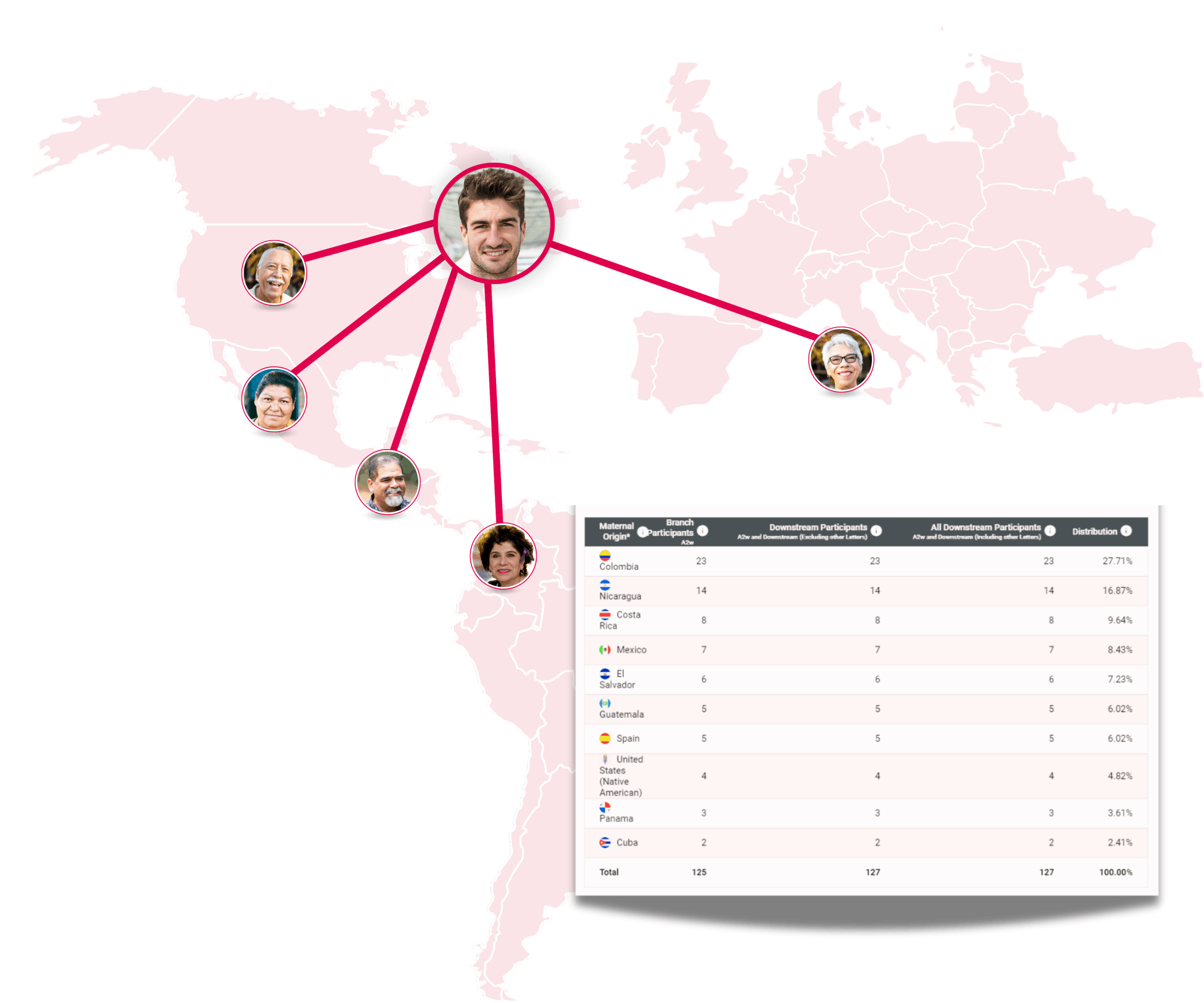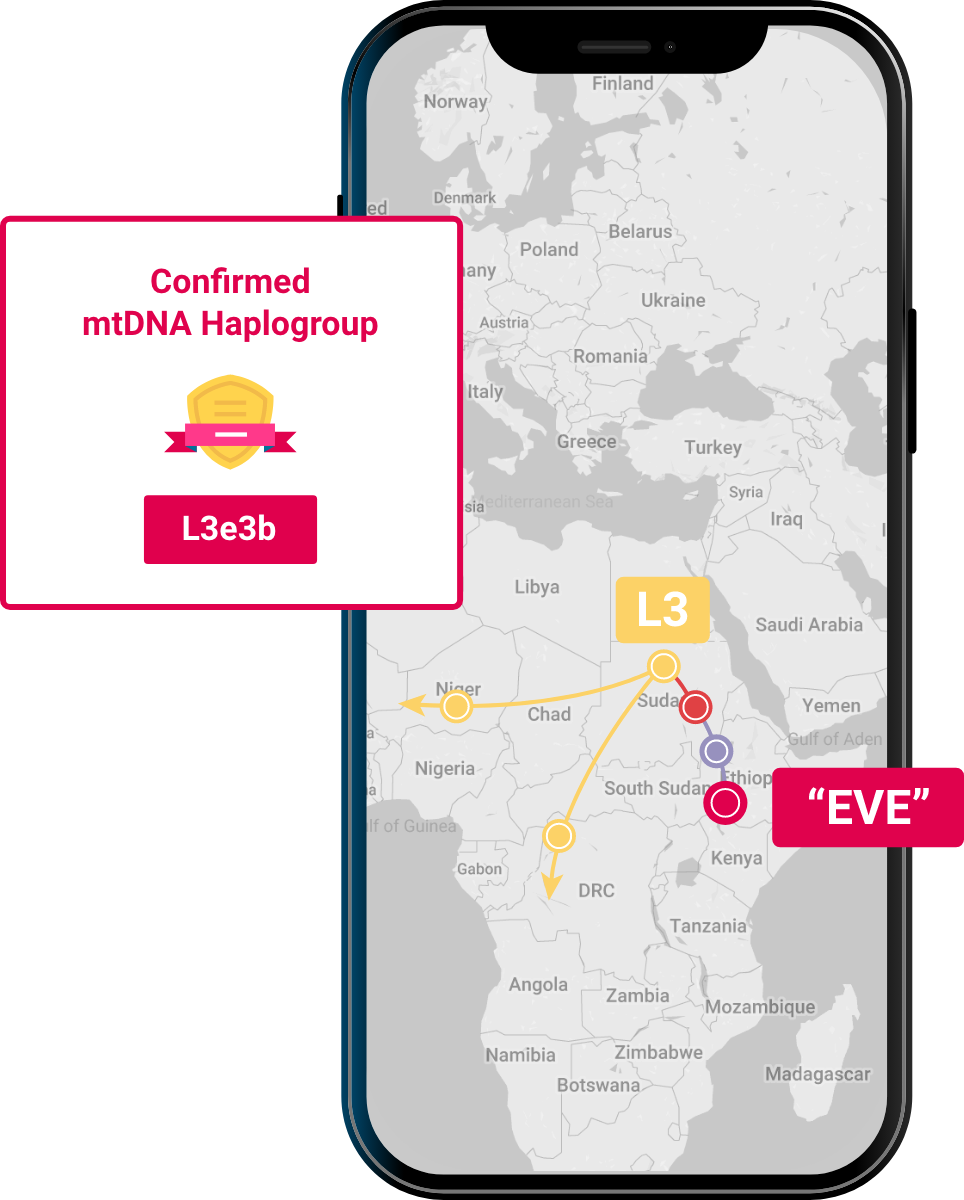HOLIDAY SALE—$30 OFF MTDNA
Explore the journey only mtDNA can tell.
Break maternal-line brick walls, connect with your mtDNA matches, and follow your mother’s mother’s line.
ONLY $129USD
SAVE $30 (WAS $159)A test for both biological males and females, mtDNA is used to help answer questions about relatedness on the direct maternal line.
WHO CAN USE MTDNA TESTING?
mtDNA is passed down from mother to all children
While both males and females inherit mtDNA, only biological females can continue to pass on mtDNA. mtDNA testing can help you discover and verify your direct maternal ancestry by connecting you with other individuals who are descendants of a shared common matrilineal ancestor.

CONNECT WITH YOUR mtDNA RELATIVES
Join the World’s Largest mtDNA Database
Trace your matrilineal ancestry and connect with relatives who share a common maternal ancestor. Whether it’s a grandmother from recent generations or an ancestor from centuries ago, our mtDNA test helps you uncover and understand your maternal heritage.
- Discover relatives who share your maternal lineage.
- Explore detailed family trees of your matches.
- Trace your matrilineal line through history to uncover maternal ancestors.
DISCOVER YOUR mtDNA HAPLOGROUP
Follow the path of your direct matrilineal ancestors
Use mtDNA to determine where your direct maternal line’s ancestors came from, their locations in historic times, and how they migrated throughout the world.
- Discover your matrilineal ancestors’ ancient migration path out of, or across, Africa.
- Find your placement on the world’s largest mtDNA Haplotree.

Access FamilyTreeDNA Discover™
New reports based on your confirmed mtDNA haplogroup

mtDNA GROUP PROJECTS
Join, contribute, or start a Group Project
- mtDNA Geographical Projects: Look at the overall mtDNA profiles of a specific region, whether it’s an entire country or just a county. The group’s purpose is to show the tested makeup of that area.
- mtDNA Lineage Projects: Look at individuals with or suspected of having the same maternal line.
- mtDNA Haplogroup Projects: Focus on mtDNA haplogroups or subclades, their origins, and their spread through time and geographic regions.
Real stories from real mtDNA customers
Through the mtDNA test, I broke down a brick wall and discovered the identity of my great-grandmother. I then traced my maternal lineage to a fascinating connection—King Louis XIV sponsored my 10th great-grandmother to relocate to Canada.
— Georgian, Verified mtDNA Tester
FREQUENTLY ASKED QUESTIONS
Have questions? We have answers.
Here are the most frequently asked questions about FamilyTreeDNA. If you have additional questions, feel free to visit our Help Center or reach out to our Customer Service team.
What is mtDNA?
mtDNA refers to mitochondrial DNA which is passed from mother to child. While men receive mitochondrial DNA from their mother, they do not pass it on to their children. Testing mtDNA allows for investigation into your maternal line and can help identify living relatives whose mtDNA is similar to yours, as well as ancient migration routes your maternal ancestors may have taken.
What is a Haplogroup?
Every individual who takes one of our mtDNA tests will also receive their mtDNA haplogroup. When humans left Africa tens of thousands of years ago, they departed in small groups that migrated into different parts of the world. Over many generations, each group developed distinct mutations allowing us to identify one from the other. We call these groups of mutations haplogroups, and they can tell us which migratory routes our maternal ancestors traveled.
I have questions about my mtDNA results, where can I go?
If you have questions about any of your results, you can either contact one of our Customer Support Representatives or look through our mtDNA pages in our Help Center to learn all about mtDNA testing!
How can I figure out who my closest matches are?
How can I learn where my matrilineal ancestors are from?
Your mtDNA results will provide you with a migration map that shows you the path your ancient matrilineal ancestors took out of or across Africa tens of thousands of years ago. You can also learn more about your recent matrilineal ancestry from connecting with your matches and utilizing tools that come with the results to learn more about where your matches’ maternal Earliest Known Ancestors are from. Because you will share a common ancestor with your matches, you will also share a common geographic location with them. The tools included with the results and connections you make with your matches can help you determine where that location might be and who that common ancestor was.
What do all those letters and numbers mean?
The Mutations page breaks down your raw sequence for your mtDNA test results. Your mutations determine your matrilineal genetic signature, meaning both the ancient migration path that your direct maternal ancestors took and who your closest matrilineal matches are.
We compare your DNA to two reference sequences, the Reconstructed Sapiens Reference Sequence (RSRS) and the Revised Cambridge Reference Sequence (rCRS).
For the RSRS, each mutation will be grouped by region of the mitochondria, and then listed with the nucleotide base (A, T, G, C) read in the DNA of the reference found at the position, followed by the position, and then the nucleotide base (A, T, G, C) read in your DNA. For example, C16222T means that at position 16222, the reference sequence has a C and your DNA has a T.
For the rCRS, you will see another section that lists all of your mutations in a chart, broken down by each region of the mitochondria. The column headers in the rCRS mutations chart provide the following information:
Position: The location of the mutation
CRS: The nucleotide base (A, T, G, C) read in the DNA of the Cambridge Reference Sequence
Your Result: The nucleotide base (A, T, G, C) read in your DNA at this position. Blank means your DNA matches the Cambridge Reference Sequence.
Some mutations will be defined by a letter other than A, T, G, or C. These are mutations in progress, and they are referred to as heteroplasmies. Learn more
Are mtDNA matches close relatives or distant cousins?
Most mtDNA matches will be distant relatives, potentially sharing an ancestor hundreds of years ago. However, if your match has a genetic distance of 0, you may have a more recent common maternal ancestor.
Can mtDNA test be combined with Autosomal DNA?
Combining mtDNA with autosomal DNA (Family Finder) gives you a more comprehensive view of your ancestry. For recent genealogy, we recommend using a combination of Family Finder, mtDNA, and even Y-DNA to confirm maternal-line relationships while also connecting with relatives across all branches of your family tree.